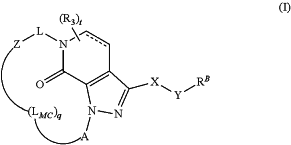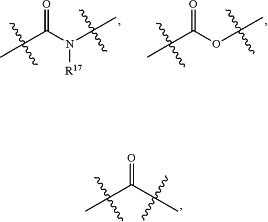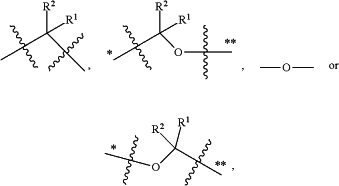| CPC C07D 243/10 (2013.01) | 38 Claims |
|
1. A compound of Formula (I), or a pharmaceutically acceptable salt thereof,
 wherein:
X is
 a 5-6 membered heteroaryl having 1 to 4 heteroatoms independently selected from N, O and S as ring members, or a saturated or partially saturated 5-6 membered heterocyclyl containing 1 to 4 ring members independently selected from N, NH, NR17, O or S;
Y is a bond,
 wherein the * of Y indicates the point of attachment to X and the ** of Y indicates the point of attachment to RB;
q is 0;
LMC is absent, and Z is W, and A is R4;
RB is phenyl, pyridinyl, thiophenyl, pyrimidinyl, or a 5-8 membered cycloalkyl, wherein RB is optionally substituted with 1 to 3 R5 groups;
R1 is selected from H, C1-C3alkyl and C1-C3alkyl substituted with 1 to 3 —OH groups;
R2 is selected from H, C1-C3alkyl and C1-C3alkyl substituted with 1 to 3 —OH groups;
or R1 and R2 taken together with the carbon to which they are attached can form a 3-6 membered cycloalkyl ring;
t is 0, 1 or 2;
each R3, when present, is a substituent on the ring to which -L-W is directly attached, wherein each R3 is independently selected from halo, CN, C1-C3alkoxy, C1-C3alkyl, C(═O)OR10, and C(═O)NR13R14;
R4 is H, C1-C3alkyl, C3-C6cycloalkyl, —(CH2)2O(CH2)2Br or a C1-C3alkyl substituted with 1 to 2 groups independently selected from —OH, —C(═O)R15 and R10;
each R5 is independently selected from halo, —CN, hydroxy, —NR13R14, C3-C6cycloalkyl, C1-C3alkoxy, C1-C3haloalkyl, and C1-C3alkyl optionally substituted with 1 to 3 R6 groups, wherein when RB is substituted with two R5 and each R5 is a C1-C3alkyl optionally substituted with 1 to 3 R6 groups, when directly attached to the same carbon atom, may be taken together with the carbon to which both are directly attached to form a 3-5 membered cycloalkyl ring optionally substituted with 1 to 3 R6 groups;
each R6 is independently selected at each occurrence from halo, hydroxy, CN, C1-C3alkoxy, C1-C3alkyl, and C3-C5cycloalkyl,
or two R6 groups, taken together with a carbon atom to which both are directly attached may form a 3-5 membered cycloalkyl ring or a 4-6 membered heterocyclic ring containing O, N or S as a ring member and optionally substituted with 1 to 2 groups independently selected from oxo and C1-C3alkyl;
L is a C1-C4 straight chain or branched alkylene linker, or L can be a C1-C4 straight chain or branched alkylene linker or a bond when W is an optionally substituted ring;
W is H, —OH, —OR10, —C(═O)NR13R14, —C(═O)OR13, —NR13R14, —NR13C(═O)OR10, —NR13C(═O)R10, —SO2R10, —SO2NR13R14, —NR13SO2R10, —P(═O)(OR13)2, —S(═O)R10, —S(═O)(=NR13)R10, —CR11R12C(═O)NR13R14, —CR11R12C(═O)OR13, —CR11R12NR13R14, —CR11R12NR13C(═O)OR10, —CR11R12NR13C(═O)R10, —CR11R12SO2R10, —CR11R12SO2NR13R14, —CR11R12NR13SO2R10, —CR11R12P(═O)(OR13)2, —CR11R12S(═O)R10, —CR11R12S(═O)(=NR13)R10, a 3-6 membered cycloalkyl, phenyl, a saturated or partially saturated 5-6-membered heterocyclyl containing one or two ring members independently selected from N, NH, NR17, O or S, or a 5-membered heteroaryl having 1 to 4 heteroatoms selected from N, O and S as ring members that is optionally fused to phenyl,
wherein the 3-6 membered cycloalkyl, phenyl, saturated or partially saturated 5-6-membered heterocyclyl and 5-membered heteroaryl of W are each optionally substituted with 1 to 3 groups independently selected from C1-C3alkyl, oxo, halo, C1-C3haloalkyl, —OH, —OR10, —OC(═O)NR13R14, —SO2R10, —SO2NR14R10, —SO2NR13R14, —SO2N═CR13NR13R14, —SO2NR13C(═O)R10, —C(═O)NR13SO2R10, —S(═O)R10, —S(═O)(=NR13)R10, —NR13SO2NR13R14, —NR13SO2R10, —NR13R14, —NR13C(═O)R13, —NR13C(═O)OR10, —C(═O)NR13R14, and —C(═O)OR13;
R10 is selected from C1-C5alkyl, C1-C3haloalkyl, 3-6 membered cycloalkyl, phenyl, 5-6 membered heteroaryl having 1 to 4 heteroatoms independently selected from N, O and S as ring members, and saturated or partially saturated 4-6 membered heterocyclyl containing 1 to 2 ring members independently selected from N, NH, NR17, O or S,
wherein each R10 is optionally substituted with 1 to 5 groups independently selected from C1-C4alkyl, deuterium, C1-C4haloalkoxy, —OH, —CN, —OC(═O)R14, -L3OR13, C1-C2haloalkyl, oxo, -halo, —C1-C3alkoxy, —OC(═O)NR13R14, —SO2R13, —SO2NR13R14, —SO2NR13C(═O)R13, —C(═O)NR13SO2R13, —S(═O)R13, —S(═O)(=NR14)R13, —NR13SO2NR13R14, —NR13SO2R13, —NR13R14, —NRC(═O)R13, —NR14C(═O)OR13, —C(═O)NR13R14, —C(═O)OR13, (saturated or partially saturated 4-7-membered heterocyclyl containing 1 to 2 ring members independently selected from N, NH, NR17, O or S), —C3-C5cycloalkyl, and (5-6 membered heteroaryl ring having 1 to 4 heteroatoms comprising 1-4 nitrogen atoms, 0 or 1 oxygen atoms, and 0 or 1 sulfur atoms as ring members), where the C1-C4alkyl, saturated or partially saturated 4-7-membered heterocyclyl, C3-05cycloalkyl and 5-6 membered heteroaryl ring are each optionally further substituted with 1 to 3 groups independently selected from halo, C1-C3alkyl, C1-C3haloalkyl, —OR13, —CN, and —NR13R14;
R11 and R12 are each independently selected from H and C1-C4alkyl;
each R13 is independently selected from H, C1-C4alkyl, a saturated or partially saturated 4-7-membered heterocyclyl containing 1 to 2 ring members independently selected from N, NH, NR17, O or S, and a C3-C6cycloalkyl, wherein the C1-C4alkyl, the saturated or partially saturated 4-7 membered heterocyclyl, and the C3-C6cycloalkyl are optionally substituted with 1 to 3 groups independently selected from C1-C4alkyl, halo, —OH, —NR15R16, —C(═O)OR15, C1-C2alkoxy and C1-C4alkyl substituted with 1 to 2 hydroxy groups;
R14 is selected from H, C1-C4alkyl and C3-C6cycloalkyl, wherein the C1-C4alkyl and C3-C6cycloalkyl are optionally substituted with 1 to 3 groups independently selected from C1-C4alkyl, halo, —OH, —NR15R16, C1-C2alkoxy and C1-C4alkyl substituted with 1 to 2 hydroxy groups;
or R13 and R14, taken together with a nitrogen atom to which both are directly attached, can form a 4-6 membered ring optionally containing an additional N, O or S as a ring member and optionally substituted with one to three groups selected from C1-C2alkyl, C1-C2alkoxy, oxo, and hydroxy;
R15 and R16 are each independently selected from H and C1-C4alkyl;
each R17 is independently selected from H, C1-C4alkyl and C3-C8cycloalkyl,
or R17 is C1-C4alkyl which, together with a nitrogen atom to which it is directly attached and a nitrogen atom from the pyrazole ring, can form a 5-8 membered ring fused to the pyrazole ring;
L3 is a bond or a straight chain or branched C1-C3alkylene;
and
‘- - - ’ represents a single or double bond.
|